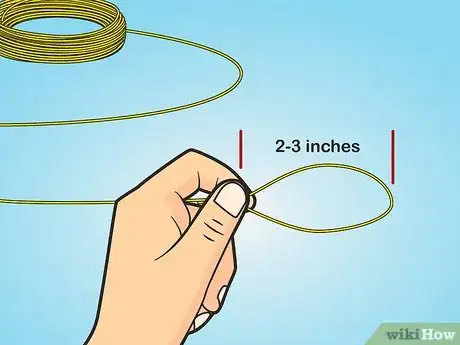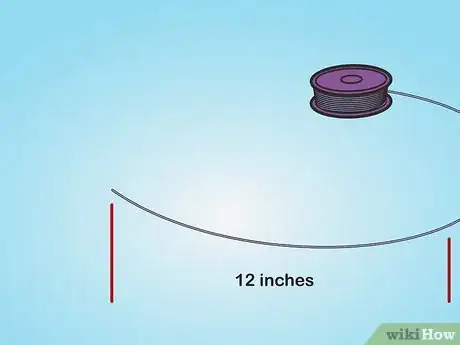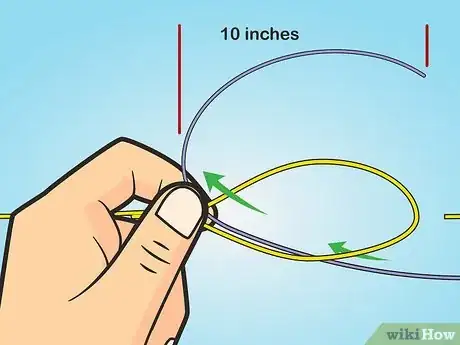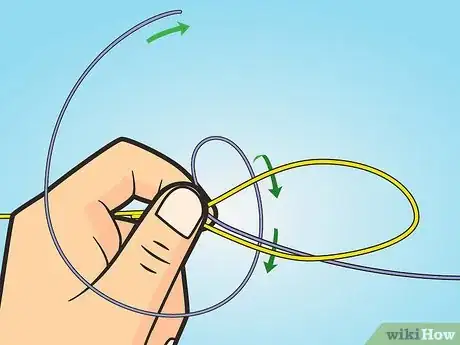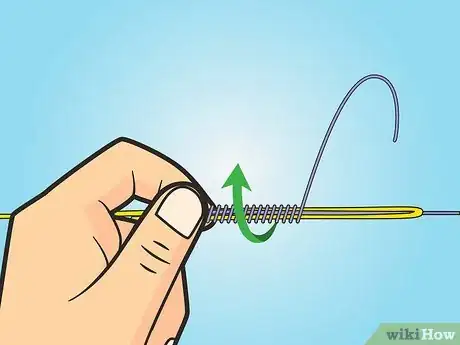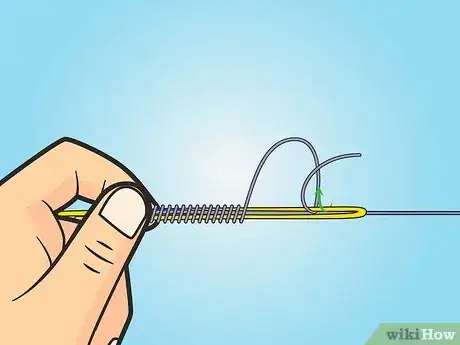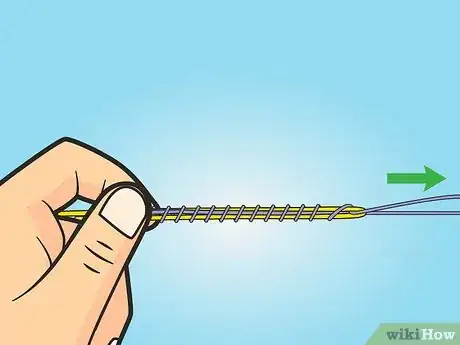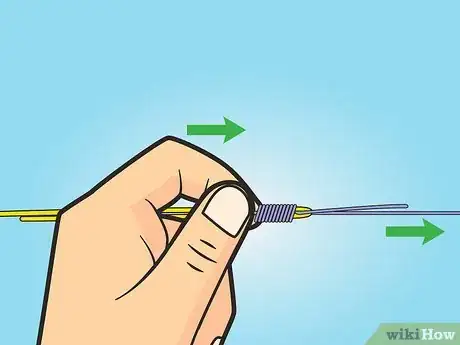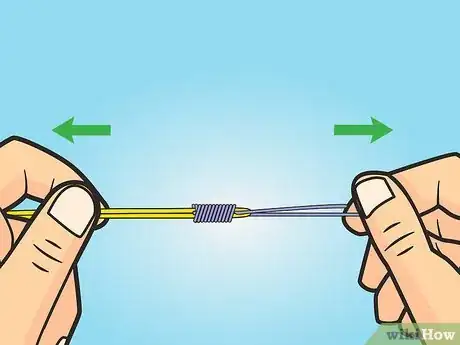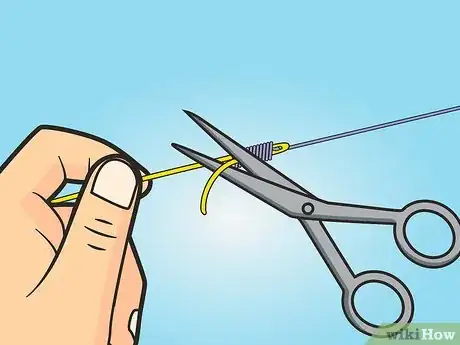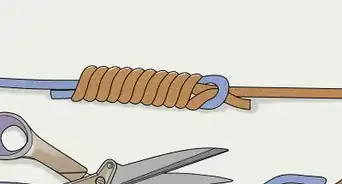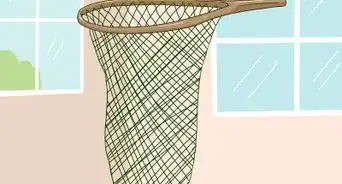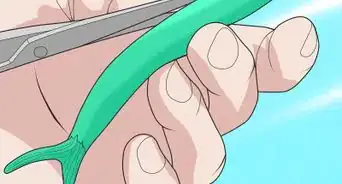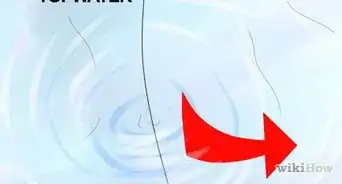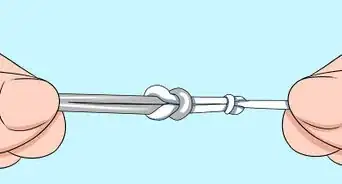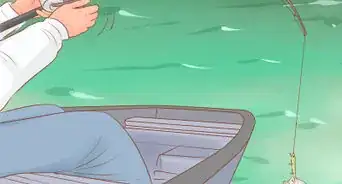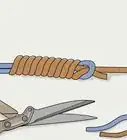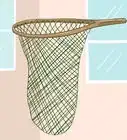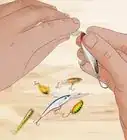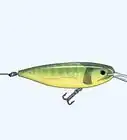This article was co-authored by wikiHow Staff. Our trained team of editors and researchers validate articles for accuracy and comprehensiveness. wikiHow's Content Management Team carefully monitors the work from our editorial staff to ensure that each article is backed by trusted research and meets our high quality standards.
There are 8 references cited in this article, which can be found at the bottom of the page.
This article has been viewed 53,479 times.
Learn more...
The fly line is an important component of a fly fishing rod. It must be attached properly to the backing on your rod to make catching and reeling in fish easier. Tying backing to the fly line can be done easily by using a tight, properly trimmed Albright knot. Once the knot is secure, you can then finish setting up your rod so you are all set to go fly fishing.
Steps
Making an Albright Knot
-
1Unwind 2 to 3 feet (61 to 91 cm) of fly line and form a loop at the end. Use your thumb and forefinger to form a small loop that is 2 to 3 inches (5.1 to 7.6 cm) in diameter at the end of the fly line. Pinch the end of the loop tight between your fingers.[1]
- You can get high quality fly line at your local fishing supply shop or online.
-
2Roll out 1 foot (30 cm) of backing line from the spool. You won't need this much backing line, but it's easier to work with more line than you need. Keep the backing line attached to the spool -- the unspooled, loose end is known as the live end.
- Use thin backing line made for fly fishing, as it will be strong enough to work properly.
Advertisement -
3Insert 10 inches (25 cm) of backing line through the loop. Slide the backing line up through the loop and place it at the end of the loop, between your thumb and forefinger. There should be at least 10 inches (25 cm) of backing line hanging off one side of the loop, called the tag end.[2]
- Maintain a firm grip on the backing line and the loop on the fly line with your thumb and forefinger. Make sure neither line slips or moves.
-
4Wrap the tag end over the fly line and the live end of the backing line. Pinch the backing line tight against the fly line with your thumb and forefinger on your left hand. Use your right hand to wrap the tag end of the backing line around the loop. Hold the tag end tight with your right thumb and forefinger as you wrap it away from your left hand, towards the end of the loop.[3]
- The backing line should cover the loop in the fly line as you wrap it.
-
5Loop the tag end over the fly line 10-12 times. Continue to hold the fly line and backing line tight between your thumb and forefinger as you wrap the tag end of the backing line over the loop. The spool end of the backing line should sit against the loop and be drawn into a knot as you wrap the tag end.[4]
- Use your middle finger to guide the tag end over the loop so the backing line sits snugly against the loop.
- Wrapping the tag end over the fly line several times will ensure the knot is tight and strong.
-
6Push the tag end through the top of the loop. Once you have wrapped the tag end around the loop at least 10 times, slide the tag end through the top of the loop and pull it through. Let the tag end sit flat in the loop, next to the backing line on the spool.[5]
Tightening the Knot
-
1Pull on the live end of the backing line to shorten the tag end. Keep your thumb and forefinger on the knot you made with the tag end around the loop. Pull on the backing line attached to the spool, or the live end, to shorten the tag end so it is 4 to 5 inches (10 to 13 cm) long.[6]
-
2Push the knot towards the end of the loop. Hold the live end of the backing line with your right hand and pull it as you push the knot slowly with your thumb and forefinger. The knot should slide towards the end of the loop, making the loop smaller and smaller. Keep pulling the live end of the backing line as you push the knot so it stays tight.[7]
- Stop pushing the knot once it reaches the end of the loop on the fly line, as you do not want it to slide off the fly line.
-
3Pull the backing line and the fly line to tighten the knot. Place the thumb and forefinger on your left hand around the fly line. Wrap the thumb and forefinger on your right hand around the live end of the backing line. Pull both lines tightly at the same time so the knot is secure.
- You can also pull tight on the tag end of the backing line while pulling the fly line to make sure the knot is extra tight.
- To ensure the knot is secure, hold the tag end of the backing line with a pair of forceps or pliers and pull it tight while holding the fly line.
Finishing off the Knot
-
1Trim the tag end of the backing line with scissors. Now that you have created the Albright knot, cut off the tag end, or loose end, of the backing line with scissors, trimming as close as possible to the knot.[8]
- Be careful not to cut off any of the live end of the backing line.
-
2Cut off the tag end of the fly line. You should also cut off the tag end of the fly line (the loose end of the loop you made with the fly line) by trimming it off as close as possible to the knot with scissors.
- Make sure you do not cut off the live end of the fly line, as this will ruin all your hard work.
-
3Moisten the knot with your tongue or wet fingers to ensure it is tight. Wetting the knot slightly will help the fly line to adhere to the backing line and keep the knot tight.
Things You’ll Need
- Fly line
- Backing line
- Scissors
- Forceps or pliers (optional)
References
- ↑ https://www.youtube.com/watch?v=i2Y0nHo9ujc&feature=youtu.be&t=16
- ↑ https://www.youtube.com/watch?v=i2Y0nHo9ujc&feature=youtu.be&t=20
- ↑ https://www.youtube.com/watch?v=i2Y0nHo9ujc&feature=youtu.be&t=35
- ↑ https://www.youtube.com/watch?v=i2Y0nHo9ujc&feature=youtu.be&t=52
- ↑ https://www.youtube.com/watch?v=i2Y0nHo9ujc&feature=youtu.be&t=61
- ↑ https://www.youtube.com/watch?v=i2Y0nHo9ujc&feature=youtu.be&t=69
- ↑ https://www.youtube.com/watch?v=i2Y0nHo9ujc&feature=youtu.be&t=78
- ↑ https://www.youtube.com/watch?v=i2Y0nHo9ujc&feature=youtu.be&t=144
